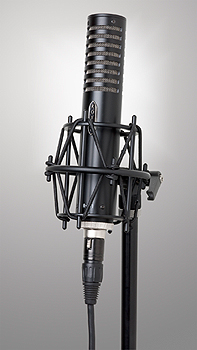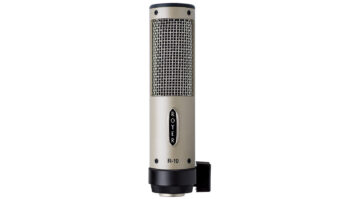
The R-101 has a triple-layer windscreen system.
Passive ribbon microphones represent a category of transducers that really makes my day. Their tonal color, pattern characteristics and transient response are unlike any condenser or moving-coil dynamic microphone. However, unless you are careful or the manufacturer builds in protection, they are sensitive to wind and drop-shock, not to mention phantom power, which in some cases can turn any passive ribbon mic into a mere paperweight. While the Royer R-101 ($895) reviewed here has the same phantom-power issues that any passive ribbon mic has, Royer has gone a long way in the design to make the mic more sturdy and “amateur-resistant.”
The matte-black R-101 ships with a sturdy, elastic spider-mount and case, and this mic is longer and more rotund than Royer’s other familiar passive model, the R-121 ($1,395). Both microphones use the same 2-inch, 2.5-micron-thick corrugated ribbon. Yet, while the R-101 has a triple-layer windscreen that reduces proximity effect, the R-121 has a single windscreen. The R-101 also has an internal shock-mount; the ribbon transducer screws onto a plate that is separated from the mounting beneath it by four silicon grommets. These design features make the mic more forgiving when it isdropped and when wind is introduced directly onto the ribbon—neither of which is recommended, of course. The ribbon element is so well-protected that during Royer’s torture tests, which involved using an air compressor, the manufacturer really had to go to extremes to cause the R-101 model to fail.
JUST USE ME
Because of its design characteristics, the R-101 is best suited for higher-SPL applications where the top-end needs taming and detail in that range is not the main thrust of the recording. For example, this microphone is not a good choice for drum overheads or lightly played acoustic guitar or piano. However, the R-101 sounds great in front of a guitar amp or on hand percussion.
I first heard the R-101 used on a Fender guitar amp that had been placed in front of the speaker just where the dust cover meets the cone. I A/B’d it with a Cloud active ribbon microphone. The R-101 exhibited some prominent bottom end and hung in well with the Cloud ($1,799), which had a more pronounced midrange. The track sounded great either with the R-101 alone or with the Cloud mic as a partner.
Next, I parked the R-101, the Cloud and an SE Electronics Voodoo VR1 ($799) passive mic in front of a kick drum in a tight array and used the Manley MicMaid to audition all three through a single SSL E Series preamp. On two separate sessions, the Voodoo VR1 beat both the Cloud and the R-101, providing the tightest and best low-end thump. However, in another session the R-101 rocked at the bottom of a floor tom with an AKG D 112 at the top. This combo offered plenty of stick definition and boom when I flipped the R-101 out of polarity.
The R-101 was just the ticket for shakers, bells and Vibratone on another session, taking the edge off the hand percussion while taming the transients and seating them well in the mix.
DO YOU NEED 101 REASONS?
The R-101 is a good-sounding, entry-level mic. Of course, the question will arise: “How does it hold up against to an R-121?” The answer is, pretty well. Yes, the R-121 is richer, has more bottom end, is slightly more open at the top and offers about 1dB more of output. But the questions for you, the reader, are: Do I have roughly $500 more to move up to the R-121 and what will be the main use of this mic? The upside of the R-101 would be its almost windproof ribbon and resistance to drop failure. If you’re taking your act on the road and recording tracks, or are looking to get into the ribbon game for not a lot of money, this is your mic.

Click on the Product Summary box above to view the Royer R-101 product page.







